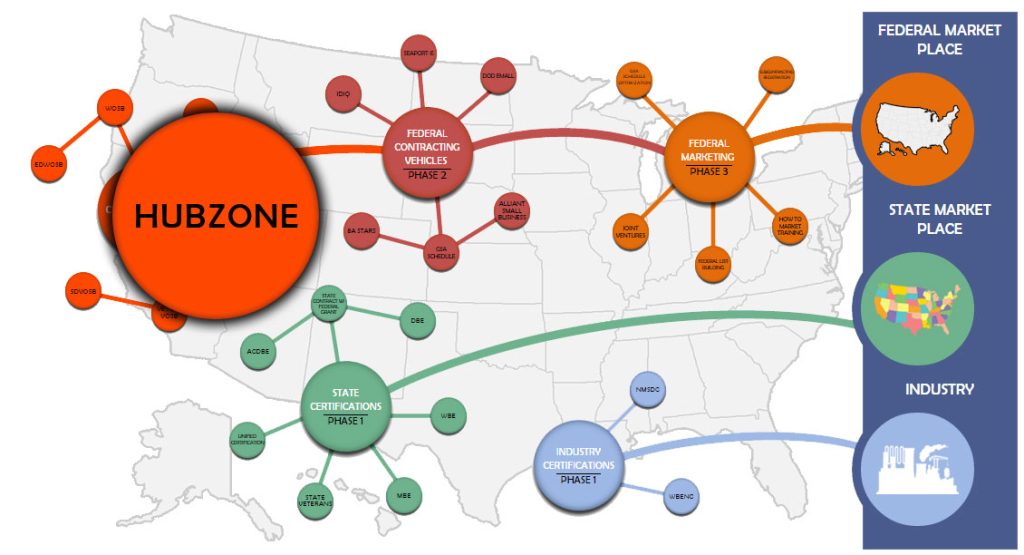Why HUBZone Firms Are Underserved and Overqualified
Despite being designed to empower small businesses in economically distressed areas, many HUBZone-certified companies remain underutilized in federal contracting.
That is not because they lack capability. It is because they often lack access to the right federal contracting vehicles, especially the GSA Schedule.
If you are already HUBZone-certified, you are halfway there. But to truly scale in the federal space, pairing your HUBZone status with a GSA Schedule is the competitive edge you need.
This article breaks down exactly how to do that without waiting 12 months to become eligible.
What Is the HUBZone Program?
The HUBZone (Historically Underutilized Business Zone) Program is a Small Business Administration (SBA) certification initiative that provides contracting advantages to small businesses operating in designated economically disadvantaged areas across the United States.
The intent of the HUBZone Program is to drive economic development and create jobs in underserved communities by encouraging the federal government to contract with businesses located in and employing people from these areas.
To qualify, a business must:
- Be a small business by SBA standards
- Be at least 51% owned and controlled by U.S. citizens
- Have a principal office located in a designated HUBZone
- Ensure that at least 35% of its employees reside in HUBZone areas
Certified HUBZone businesses are eligible for:
- Set-aside contracts (competitive contracts where only HUBZone firms can bid)
- Sole-source contracts (contracts awarded without competition if certain conditions are met)
- A 10% price evaluation preference in full and open contract competitions
Federal agencies have annual spending goals that include allocating at least 3% of their prime contracting dollars to HUBZone-certified small businesses. Despite this, the federal government consistently falls short of meeting that target, which means opportunity is abundant for certified firms who are also strategically positioned.
That strategic positioning starts with the GSA Schedule.
What Is HUBZone GSA Assistance?
HUBZone GSA assistance refers to tailored services and strategies that help HUBZone-certified businesses navigate and successfully secure a GSA Schedule, gain federal visibility, and tap into HUBZone set-aside contracts.
This includes:
- Guidance on GSA Schedule application requirements
- Federal pricing strategy
- SBA and GSA alignment
- Compliance with both GSA and HUBZone program rules
Combined, this unlocks both set-aside and sole-source opportunities, especially under programs like GSA OASIS+ HUBZone pools.
Why Combine HUBZone Certification with a GSA Schedule?
Here is the strategic win:
HUBZone Certification
GSA Schedule
| SBA program offering preferential contract access for firms in underutilized business zones | Governmentwide acquisition contract (GWAC) used by federal buyers to procure pre-vetted vendors efficiently |
| Offers set-asides and sole-source awards | Makes your business searchable and preferred by federal agencies |
| Focuses on community development via 35% employee residency rule | Focuses on procurement streamlining and price negotiation |
Together, these designations make your business a preferred, compliant, and accessible vendor to agencies under pressure to meet small business utilization goals, especially in HUBZone-designated areas.
Common Barriers to GSA Schedule Entry for HUBZone Firms
Even with SBA certification in hand, most HUBZone companies do not make it past the GSA entry point because of the following:
1. Lack of Federal Procurement Language
Commercial terminology in your service catalog does not align with GSA’s contracting SINs (Special Item Numbers). This mismatch causes delays or outright rejection.
2. Incomplete Compliance Documentation
HUBZone businesses often lack properly formatted past performance narratives, pricing templates, or technical proposals required by GSA.
3. Underutilizing Their HUBZone Status
Many businesses fail to highlight their HUBZone certification in their GSA application or vendor profile. This omission prevents federal buyers from discovering them when searching specifically for HUBZone-qualified vendors.
How to Get on the GSA Fast as a HUBZone Business
If you want to get on GSA fast while leveraging your HUBZone status, follow this streamlined path:
Step 1: Audit Readiness
Make sure you meet GSA minimums:
- Two or more years in business
- Verifiable past performance
- SAM.gov registration
- DUNS/UEI and NAICS/SIN alignment
- HUBZone certification with active SBA status
Step 2: Craft a GSA-Aligned Offer
Translate your capabilities into federal-friendly terminology. Map services to GSA IT SINs or Professional Services SINs. Include proof of pricing structure and service delivery methodology.
Step 3: Highlight Your HUBZone Advantage
Mention your HUBZone status on all capability statements, technical narratives, and your GSA Advantage profile. This increases your chance of being discovered for HUBZone set-asides and sole-source opportunities.
Step 4: Submit via GSA eOffer Portal
Use the GSA’s secure submission system. Be prepared to respond to Contracting Officer inquiries quickly to avoid stalling the process.
Final Checklist: Are You GSA-Ready as a HUBZone Firm?
- HUBZone certification is active
- Registered in SAM with correct NAICS codes
- Past performance meets GSA minimums
- Pricing structure is audit-ready
- Service descriptions mapped to GSA SINs
- Capability statement emphasizes HUBZone value
Still unsure? We help businesses build custom GSA application strategies that maximize their HUBZone advantage and minimize wasted time.
Do Not Let Your HUBZone Certification Go Underutilized
You have already done the hard work of earning your certification. Now it is time to translate it into recurring revenue.
Federal agencies have HUBZone quotas they are actively trying to meet. Many are searching for qualified vendors like yours who are both certified and procurement-ready.
Request a Free HUBZone GSA Readiness Audit and gain clarity on your position, your gaps, and how quickly you can begin securing set-aside contracts.
